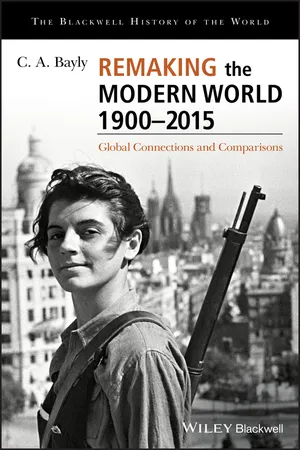History
America in the 1950s
The 1950s in America was a period of economic prosperity, technological advancement, and cultural transformation. It was characterized by the rise of consumer culture, suburbanization, and the baby boom. The era also saw the beginnings of the civil rights movement and the Cold War, shaping the social and political landscape of the country.
Written by Perlego with AI-assistance
Related key terms
2 Key excerpts on "America in the 1950s"
- eBook - ePub
Remaking the Modern World 1900 - 2015
Global Connections and Comparisons
- C. A. Bayly(Author)
- 2018(Publication Date)
- Wiley-Blackwell(Publisher)
“The Bomb” stood as the dark antithesis to the ideology of high modernism which had already been announced before the war in art, architecture and literature. Yet, the atomic age also saw a great explosion of peaceful scientific advances: the creation of nuclear power reactors, aircraft which could break the sound barrier and advances in medicine following the sequencing of DNA in the early 1950s. Indirectly, the Cold War and the fear of nuclear catastrophe powered a huge improvement in education across the world, while it focussed the minds of European statesmen on Europe itself, contributing to the final liberation of most colonial peoples by the mid-1960s. Advances in communication, notably television, expanded the range of youth culture and empowered a new form of democracy. Wartime advances in contraception and the later dissemination of “the pill” helped bring about the feminist revolution of the 1960s and 1970s. This chapter, then, examines the political paradoxes of the years from the mid-1950s to the late 1970s: the period of high scientific modernism and worldwide ideological conflict, which was also an unequalled period of popular liberation.America Regnant
In 1953, the American post-war boom was in full swing and the Korean War had ended, though in military deadlock. The Stalinist era was drawing to a close, Japan had been returned to diplomatic normality and Europe was beginning to emerge from the devastation of the Second World War. By 1979, European imperial rule had finally come to an end in Africa and the Iranian revolution was underway, signalling the beginnings of an Islamic revival across the world. This was soon to be followed by the Soviet invasion of Afghanistan and the death throes of the Communist system itself. China was by then emerging from the travails of Maoism, while the Western democracies were moving towards the free-market right wing. In retrospect, then, these intervening two and a half decades marked the peak of American economic hegemony across the world, even though its people were successively alarmed by the Cold War, the assassination of President Kennedy, the clash over black civil rights, the country's defeat in Vietnam and the sense of loss of direction under presidents Gerald Ford and Jimmy Carter.2 - eBook - ePub
American Education
A History
- Wayne J. Urban, Jennings L. Wagoner, Jr., Milton Gaither(Authors)
- 2019(Publication Date)
- Routledge(Publisher)
10 Education During and After the Crucial Decade 1945–1960Overview
Most Americans greeted the end of World War II with relief as well as expectations of material improvement. Yet the period from 1945 to the mid-1950s was full of uncertainty because of crises in both domestic and foreign affairs. These crises were so monumental that historian Eric Goldman famously referred to these years as the “crucial decade.” Goldman later extended his analysis to the year 1960, believing that events from 1955 to 1960 were largely a continuation of the previous decade. Goldman’s conception of the period frames our own analysis here.1Federal Economic Activity
As World War II was drawing to a close, many Americans looked forward to a period of relative peace in foreign affairs and increasing prosperity at home. Instead, the decade following the war was characterized by substantial economic, political, and social upheaval.Domestic conflict arose over the role the federal government would play in the nation’s future. The most important single issue was the degree to which the federal government involved itself in the American economy. The Roosevelt administrations, first in response to the Great Depression and then in reaction to wartime conditions, had charted a course of substantial federal involvement in the nation’s economic affairs.This federal economic activity resulted in policies and practices that helped lower- and working-class Americans, particularly those represented by organized labor, to move into the nation’s economic mainstream. An important issue faced by the Truman administration after World War II was whether or not federal economic intervention, on behalf of both economic prosperity and the interests of organized labor and other workers, should continue.Truman’s Postwar Policies
Harry Truman, from more humble economic origins than Roosevelt, had been a small businessman prior to becoming a politician. To some, he seemed to be bent on reversing Roosevelt’s economic policies. Early in his presidency, Truman clashed openly and vigorously with labor, threatening to draft unionized railroad workers, who were on strike, into military service. Settlement of this situation prevented the nation from learning whether or not Truman would have carried out his threat.
Learn about this page
Index pages curate the most relevant extracts from our library of academic textbooks. They’ve been created using an in-house natural language model (NLM), each adding context and meaning to key research topics.

